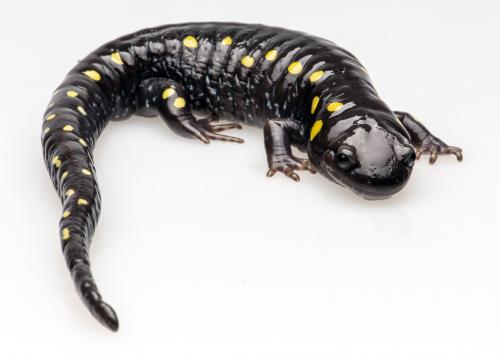
Scientific name: Ambystoma maculatum
Mi’kmaq Translation: Daqtaloq
French Translation: Salamandre maculae
Gaelic Translation: Loisgean
Physical Description
Yellow-spotted salamanders are our largest species of salamander. The head, body and tail are dark grey to blue-black. Their belly and sides are lighter blue-grey. Along the back, tail, sides, head and legs are two uneven rows of up to 54 bright yellow spots. It is rare to see an individual without spots, but it is possible. Aquatic larvae are a dull, olive-green colour with feathery gills behind the head, legs and tail.
Size
Newly metamorphosized young measure 2.6 to 3.3cm in length
Adult females measure 12.4 to 19.4cm in length
Adult males measure 10.9 to 18.3cm in length
Range and Distribution
These salamanders can be found across the Atlantic region and Northwestern Ontario. In Nova Scotia, they are common to see across the Province.
Habitat
Deciduous and mixed forests are the preferred habitat, especially those located near woodland ponds and permanent wetlands for breeding. Smaller habitats created by leaf litter, logs and rocks are used for foraging and shelter.
Diet
Adult yellow-spotted salamanders eat spiders, insects, snails, slugs, earthworms and beetles. The juveniles will eat snails and immature aquatic insects.
Reproduction and Life Cycle
Breeding occurs on rainy nights in April and May, when they migrate to their breeding wetlands. Spermatophores, which are fuzzy and similar in size to a grain of rice, are attached to objects on the bottom of the pond. Females will collect the spermatophores to fertilize their egg sacks. Up to 300 eggs, in two to four jellylike masses, are then laid underwater. The eggs are attached to pond plants, submerged sticks or other vegetation. After four to seven weeks, the eggs hatch into aquatic larvae. The larvae will then develop into terrestrial juveniles before the end of the summer. For males, sexual maturity is reached between ages three and six. For females, sexual maturity is reached by age seven. Adults may only breed once every two to three years. Once breeding season is over, adults will spend most of their time underground in burrows and cavities. This is a long-lived species, reaching 30 years of age or more in the wild.
Status
NSESA: Of Least Concern
COSEWIC: Not Assessed
Threats
Habitat loss, road mortality, climate change and pollution, along with herbicide and pesticide use, are all contributing threats for these sensitive creatures. The introduction of non-native species, like goldfish and turtles, into breeding ponds is also challenging for their populations.